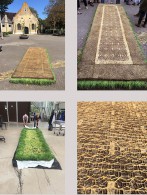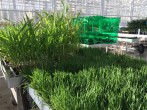

#1


#2


#3
Wageningen & Research
resource.wur.nl/en/science/show/Weaving-with-roots.htm
Anyone who has ever dropped a pot plant gets the picture. The clump of white roots has taken on the shape of the broken pot. Petrified life force. Quite beautiful really. This is more or less how it started for the German artist Diana Scherer. ‘I was fascinated by it and I took pictures and hung them up in my studio. Then I thought: what can I do with this?’ This turned out to be the start of a quest, the results of which so far can be seen in Impulse, where Scherer’s intriguing root art will be exhibited for another month.
The clumps of roots inspired Scherer to create a series of root vases: flowers in vases made out of their root systems. ‘What happened was that I discovered that every plant has its own type of roots. Every root system is different in shape and structure. Chamomile, for instance, has rough, very woolly roots. Grass has silky, white roots. One plant only makes thick ropes while another makes those tiny little hairy roots, making it rather cuddly.’
Scherer spent two summers experimenting in her studio in Amsterdam. ‘And that was not easy at all. Not every plant wants to be forced into any old vase. I had to really research that, and lots of things went wrong at first. Roots that rotted away, for instance, because it was too wet. In the end I made a book containing 32 different plants.’

Experimenting
But the real manipulation was still to come at the point. It became clear to Scherer that she wanted to carry on working on the roots after the vase phase. At some point it occurred to her that the roots could be used as yarns. ‘Then I got the idea that I wanted to weave. I thought: that’s cool, I’m going to make a textile out of this.’ Because if roots can take on the shape of a vase, why not another form imposed on them from outside?
It took Scherer over a year of experimenting before she ‘had something to show for it that looked a bit presentable.’ Exactly how she managed that is her secret. ‘I worked on this for a very long time and I don’t want other people imitating it. If someone wants to do it, they’ll have to figure it out for themselves. It’s a bit like a painter who worked for three years to get the perfect blue. That’s a trade secret, I’m not giving it away. What is more, there is potential here for new materials.’
‘Also, as an artist I feel it detracts from the magic if you know how I did it,’ adds Scherer. ‘I feel I’m betraying my work if I tell people how I do it.’ Without going into details, then, what it boils down to is that Scherer gets roots to grow in a template-like mould. And the roots do that, she explains, because they are continuously searching for food. ‘What they really want is to grow downwards in search of water and nutrients. They search in every direction and go wherever I give them space to go. The dynamics and power of the growth process are incredible.’

Manipulation
Scherer mainly works with oats and wheat. ‘Oats can be sown very close together, which gives you an extremely high volume of roots. And oats grow fast as well. In the summer I can sometimes get a pattern within two weeks. And because it grows so quickly, the roots are still very young as well. Young roots are very beautiful and have tiny little hairy roots which are rather cuddly.’ This pattern on the underside is what it is all about. When that carpet is ready, Scherer turns the ‘lawn’ over and the result is recorded with a technical camera in great detail.
Scherer’s work is all about manipulation, human control over nature. The photos show root fibres with clear-cut geometric patterns. The work raises questions about the relationships between people and the natural world. Can this still be called nature, for instance? Scherer: ‘I change a natural fibre in the root system into an artificial and textile-like fibre. That is what you do as an artist: change reality into what you want it to be. I send the roots in all directions. Maybe that’s not very nice or respectful. If I wanted to respect the will of the roots, I wouldn’t make them grown in templates. I impose my will on them and domesticate them, but I’m not ashamed of that. Manipulation is the artist’s challenge. I make nature do my bidding. And we all do that actually. Everyone prunes and mows, and we all want things to look exactly as we want them. That’s manipulation too. What I do is no different really, it’s just that you haven’t seen this before.’

Intelligent plants
There are a couple of withered flowers on the table in Scherer’s studio. ‘I think those plants are very cross with me,’ she announces suddenly. ‘Because I neglected them so badly. Plants are extremely sensitive. Especially underground. Did you know that mother trees feed their young nearby through fungi? When animals eat from plants, those plants send out signals which cause other plants to generate toxic substances that kill the animals. That’s smart! Yes, I do believe plants are intelligent. As an artist I can afford to believe that. I don’t believe a plant will every win the Nobel Prize, mind you, but I do think this kind of plant response is smart. It would be stupid of plants not to warn each other. Why shouldn’t plants have intelligence? I’m convinced of it. I think there is much more intelligence there than we realize.’
That’s smart! Yes, I do believe plants are intelligent
Good insulation material
Scherer’s work is attracting plenty of interest. She won the New Material Award at the latest Dutch Design Week in Eindhoven. Scherer’s root fibres hold out the promise of exciting new materials, say experts. ‘But it is not just new and fun,’ says Scherer. ‘Roots store CO2 too. That is interesting in ecological terms. The nice thing about it is that the material creates itself as it grows. Unlike other natural materials such as coconut fibre or cotton, you don’t have to weave it afterwards to get your product. Roots weave themselves, and that makes them an attractive prospect.’

Together with an ecologist from Radboud University in Nijmegen, Scherer is going to look for stronger roots and ways of conserving fibres. ‘Maybe it will become a kind of insulation material,’ she thinks aloud. ‘But then material you can stick onto a wall instead of behind it. Insulation which is so attractive you want to be able to see it. But this idea is still in its infancy. I’m looking for business partners.’
Root dress
There is another new challenge in the patterns Scherer works with. Up to now, Scherer found most of her inspiration in basic geometrical figures, which occur all over the place in nature. ‘The hexagon, for example, which you find in honeycombs, crystals or organic molecules. And shapes from Art nouveau, which was also very much inspired by nature. But the next step is for me to make my own patterns, together with a mathematical pattern designer. It needs to be taken a step further, so that I don’t keep it to myself anymore.’
Oh, the possibilities are endless
The possibilities for playing with roots are endless. Her first attempt at a dress made of roots lies on the table beside her. It looks pretty wearable. She also wants to work with several different kinds of roots at the same time, in her carpets. ‘A kind of intercropping. And I also want to work with several layers, for instance. Oh, the possibilities are endless.’
Diana Scherer’s exhibition Interwoven can be seen in Impulse on Wageningen Campus until Friday 3 February.
Root science
That Diana Scherer’s root art is on view in Wageningen is thanks to professor of Plant Ecology Liesje Mommer. At a symposium to mark the opening of the exhibition in December, several Wageningen researchers shed light on the wondrous world of roots, and Mommer was one of them.
Professor Mommer studies the interaction between plants and fungi in natural grasslands. Biodiversity plays an important role in this. The more species of plants the better. That is, the more different roots, the better. A greater wealth of species lead to higher productivity of the ecosystem. Mommer thinks that is because pathogenic fungi get less chance of doing their thing in soils with a variety of different root systems. It is harder for the fungi to find their favourite plants. ‘Lost in diversity,’ Mommer calls it. ‘There are so many signals, metabolic products and volatile substances given off by roots and bacteria, that pathogenic fungi lose their way.’
Another speaker at the symposium was assistant professor Jochem Evers of the Centre for crop systems analysis. Where artist Scherer forces roots to grow where she want them to, Evers seeks to model mathematically why roots of different species grow the way they do. The roots find their own way through a forest of stimuli. Evers starts simply with an established system of maize and beans, in which the yield is bigger when the two crops are grown together than when they are grown separately. The roots of beans excrete organic acids which make phosphate present in the soil dissolve. Maize then benefits from the available phosphate. And so the whole is more than the sum of the parts.
